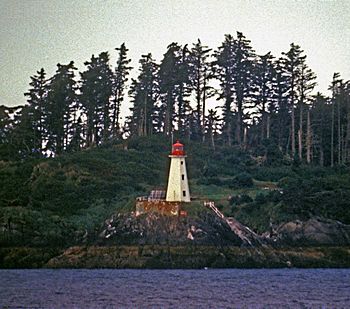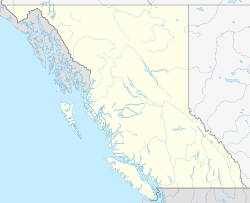Lucy Islands facts for kids

Lucy Island Lighthouse, built 1907
|
|
| Geography | |
|---|---|
| Location | Chatham Sound |
| Coordinates | 54°18′01″N 130°37′08″W / 54.30028°N 130.61889°W |
| Area | 73.95 km2 (28.55 sq mi) |
| Highest elevation | 59 m (194 ft) |
| Administration | |
|
Canada
|
|
| Province | British Columbia |
| Additional information | |
| Time zone | |
The Lucy Islands are a group of small islands off the North Coast of British Columbia, Canada. In the Tsimshian language, they are called Lax Spinna, which means "on shoulders."
These islands are low and covered with thick Sitka spruce forests. They are named after Lucy Island, the largest island in the group. The Lucy Islands are a protected area. They hold some of the oldest archaeological sites on the North Coast. They are also home to many important seabirds and a famous lighthouse from the 1900s.
Contents
Where are the Lucy Islands?
The Lucy Islands Conservancy is a group of islands located about 15 kilometers (9 miles) west of Prince Rupert. Prince Rupert is the biggest city on British Columbia's North Coast.
The islands are in the middle of Chatham Sound. They are north of where Chatham Sound meets Hecate Strait. They sit between the much larger Melville Island and Digby Island.
How the Lucy Islands Got Their Name
Captain George Henry Richards named the islands around 1862. He was on the ship HMS Hecate. He named them to honor Lucy McNeill.
Lucy McNeill was the daughter of William Henry McNeill, an official with the Hudson's Bay Company. Her mother, Mathilda, was a Kaigani Haida chief. Lucy was known for being very independent and adventurous for her time. She could travel in fancy cabins or go on long canoe trips to Indigenous villages. Later, she married Hamilton Moffatt and lived in Victoria.
People and History of the Islands
People have lived on the Lucy Islands for a very long time. Ancient shell middens (piles of shells from old meals) and house shapes show that people lived here possibly 6,000 years ago. Some of the oldest archaeological sites on the North Coast are found here. This includes the earliest known use of rectangular houses in the area.
The Lucy Islands are part of the traditional territory of the Gitwilgyoots people. They are a Tsimshian-speaking tribe. During the winter, they lived near Prince Rupert. In late spring, they would move to the outer islands, like the Lucy Islands. They would fish, gather shellfish, and hunt sea mammals. Then, in early summer, they would return to the Skeena River for the salmon runs.
In the winter of 1984-1985, strong winds blew down trees. This uncovered ancient human remains in a shell midden. The remains were of a child, a young adult female, and an older male. With permission from the Metlakatla First Nation, the Canadian Museum of History studied these remains.
A study in 2013 used new genetic methods. It linked the 5,500-year-old female remains from Lucy Islands to 2,500-year-old remains found on nearby Dodge Island. The study also found a direct matrilineal (mother-to-daughter) DNA link between the 5,500-year-old female and a living Tsimshian woman from the Metlakatla First Nation. This amazing discovery suggests that First Nations people have lived in this area for thousands of years.
By the 1900s, the only people living on the Lucy Islands were lighthouse keepers. The original light was replaced by a tower built in 1907. The Canadian Coast Guard stopped having people live at the lighthouse in 1988.
Protecting the Lucy Islands
In 2008, the government of British Columbia created the Lucy Islands Conservancy. This was done under the Protected Areas of British Columbia Act. This conservancy protects important places where seabirds nest. It also supports traditional marine food gathering and offers fun outdoor activities.
The conservancy protects 28 hectares (about 69 acres) of land on the islands. It also protects 178 hectares (about 440 acres) of the foreshore. This is the area of the coast that is covered and uncovered by tides.
The Lucy Islands Conservancy is managed together by BC Parks and the Metlakatla and Lax Kw’alaams First Nations. They have worked together to fix a boardwalk. This allows people to visit safely while protecting the old archaeological sites and bird nesting areas.
Amazing Seabirds of Lucy Islands
The islands are home to many birds. The Metlakatla Governing Council pointed out the islands' importance for birds.
The conservancy is a very important place for rhinoceros auklets to breed. These birds dig long burrows in the ground to make their nests. The Lucy Islands have the sixth-largest rhinoceros auklet colony in British Columbia. In 1983, there were 25,300 nesting pairs. This was about 5.4% of all rhinoceros auklets in the world!
In 1983, 197 pigeon guillemots were counted on the islands. This was about 1.9% of the estimated national population. The next year, only 54 pigeon guillemots were counted. glaucous-winged gulls and black oystercatchers have also been seen here.
Images for kids






